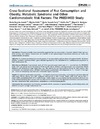Please use this identifier to cite or link to this item:
https://accedacris.ulpgc.es/jspui/handle/10553/21151
| Title: | Cross-Sectional Assessment of Nut Consumption andObesity, Metabolic Syndrome and Other Cardiometabolic Risk Factors: The PREDIMED Study | Authors: | Ibarrola-Jurado, Nuria Bulló, Mónica Guasch-Ferré, Marta Ros, Emilio Martínez-González, Miguel Ángel Corella, Dolores Fiol, Miquel Wärnberg, Julia Estruch, Ramón Román, Pilar Arós, Fernando Vinyoles, Ernest Serra-Majem, Lluis Pintó, Xavier Covas, María Isabel Basora, Josep Salas-Salvadó, Jordi |
UNESCO Clasification: | 3206 Ciencias de la nutrición | Keywords: | Nut Obesity Metabolic syndrome Cardiovascular risk |
Issue Date: | 2013 | Journal: | PLoS ONE | Abstract: | Introduction: Prospective studies have consistently suggested that nut consumption is inversely related to fatal and non-fatal coronary heart disease. Limited data are available on the epidemiological associations between nut intake and cardiometabolic risk factors.Objective: To evaluate associations between frequency of nut consumption and prevalence of cardiometabolic risk factors [obesity, metabolic syndrome (MetS), type-2 diabetes, hypertension, and dyslipidemia] in a Mediterranean population at high cardiovascular risk.Materials and Methods: Cross-sectional study of 7,210 men and women (mean age, 67 y) recruited into the PREDIMED study. MetS was defined by the harmonized ATPIII and IDF criteria. Diabetes and hypertension were assessed by clinical diagnosis and dyslipidemia (high triglycerides, low HDL-cholesterol, and hypercholesterolemia) by lipid analyses. Nut consumption was assessed using a validated food frequency questionnaire and categorized as <1, 1-3, and >3 servings/wk. Control of confounding was done with multivariate logistic regression.Results: Compared to participants consuming <1 serving/wk of nuts, those consuming >3 servings/wk had lower adjusted odds ratios (OR) for obesity (0.61, 95% confidence interval 0.54 to 0.68; P-trend <0.001), MetS (0.74, 0.65 to 0.85; P-trend<0.001), and diabetes (0.87, 0.78 to 0.99; P-trend = 0.043). Higher nut consumption was also associated with lower risk of the abdominal obesity MetS criterion (OR 0.68, 0.60 to 0.79; P-trend<0.001). No significant associations were observed for the MetS components high blood pressure, dyslipidemia, or elevated fasting glucose.Conclusions: Nut consumption was inversely associated with the prevalence of general obesity, central obesity, MetS, and diabetes in subjects at high cardiovascular risk. | URI: | https://accedacris.ulpgc.es/handle/10553/21151 | ISSN: | 1932-6203 | DOI: | 10.1371/journal.pone.0057367 | Source: | PLoS ONE [ISSN 1932-6203], v. 8 (2), e5736 (Febrero 2013) | Rights: | by-nc-nd |
| Appears in Collections: | Artículos |
SCOPUSTM
Citations
104
checked on Jun 8, 2025
WEB OF SCIENCETM
Citations
93
checked on Jun 8, 2025
Page view(s)
62
checked on Sep 23, 2023
Download(s)
110
checked on Sep 23, 2023
Google ScholarTM
Check
Altmetric
Share
Export metadata
Items in accedaCRIS are protected by copyright, with all rights reserved, unless otherwise indicated.
